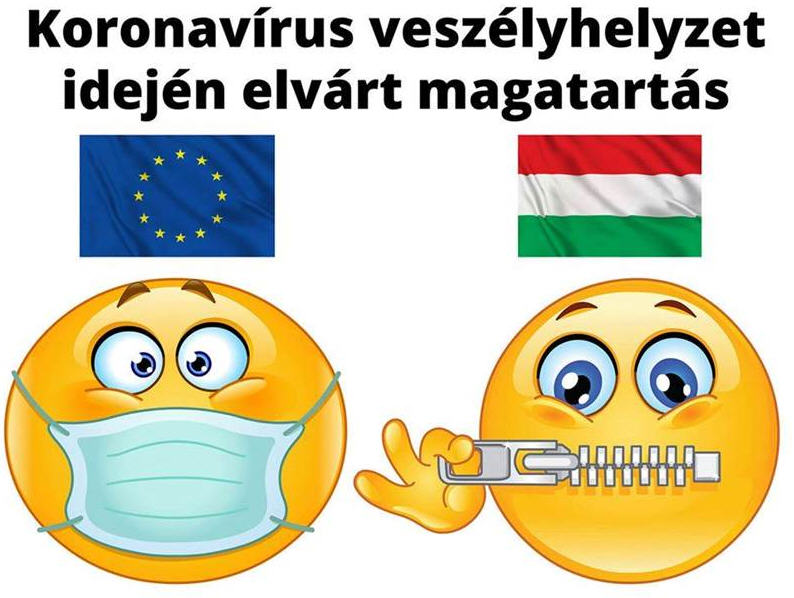
Czech citizens bid a symbolic “farewell to COVID” on the Charles Bridge in Prague, June 30, 2020. Like Hungary, the Czech Republic had much lower rates of infection than did Western Europe
Upon arrival in mid-July, Budapest seemed another world from the oppressive virus anxiety of most of the US: offices and businesses fully open; cafes and restaurants thriving, with no restrictions; few masks or other measures in sight (masks are required on public transportation, in stores and in malls, though with lax enforcement and inconsistent compliance); and movie theaters, outdoor performances and even sports events operational. (Soccer matches, with fans! Although in the long-suffering Hungarian football context, this means crowds of around 5,000—comparable to pre-pandemic ones—rather than the multiples of that that would be filling Europe’s big stadiums, were fans allowed there.)
The Hungarian government released a coronavirus action plan already at the end of January, though skimpy on details. The first concrete action, on March 1, was the suspension of refugee acceptance on the country’s (southern) border with Serbia—in a continuation of the ruling Fidesz party’s years-long overheated anti-immigrant rhetoric (despite very few actual immigrants—see my article in the October 2015 Public i), Prime Minister Viktor Orbán warned that “illegal migrants” were spreading the virus, and blamed the few cases in the country on Iranian students (students whose studies in Hungary, ironically, had been encouraged and largely funded by his government, as part of its “Eastern opening”). As official case numbers rose to a few dozen, a state of emergency was declared on March 11; instruction at schools and universities was moved online in mid-March, and lockdown measures followed—though nowhere near as strict as in, for example, Italy or France. Travel into the country was banned for non-citizens.
The dismal state of Hungarian health care—state-funded and -administered, as is the rule in Europe, but the victim of years of underinvestment and the flight of doctors to better-paying jobs in Germany and elsewhere—led many to fear a collapse if the pandemic caught hold. The government ordered over 30,000 hospital beds emptied immediately for potential COVID-19 patients, causing great suffering on the part of other patients who were suddenly moved, and their families, and an undetermined number of deaths. The government purchased 16,000 ventilators from China—at 52,000 Euros (over $60,000) each, four times what other EU countries were paying, leading to allegations of corruption at both ends of the deal.
In the end, whether because of government measures or other factors, the virus’s impact was strikingly low, even allowing for an undercount of cases due to government resistance to widespread testing. Hungary’s cumulative registered COVID-19 cases, adjusted for population, are about four percent of those in the US, though deaths—possibly because of poorer general health in the population—have been more, about one-ninth of the US’s (just over 600 total, in a country of just under 10 million population). The lockdown was lifted in mid-May.
This is not to say the virus has had no effects on the country. The economy, heavily dependent on tourism and trade, has taken a big hit, which a government relief package has only partially mitigated. But the biggest impact was political: Prime Minister Orbán —who has ruled since 2010 with a “supermajority” of over two-thirds in Parliament, allowing for smooth passage of constitutional changes, and been under almost constant pressure from the European Union (EU) for violations of EU principles on freedom of the press, independence of the judiciary, freedom of civic organizations, treatment of migrants, and other issues—on March 30 pushed through an Enabling Law, that empowered the government to suspend still-existing democratic institutions and practices, ostensibly to deal with the coronavirus crisis. Legal experts argue that the Constitution had already made it possible for the government to declare an emergency and take necessary action, so in theory there was no need for a new law. Unlike the powers allotted by the constitution, however, this law had no time limit; or, to be precise, the conditions for ending it are written in a way that leaves the sole power to retire the emergency powers to the prime minister.

The text translates: “Expected behavior during the coronavirus emergency,” with the EU flag on the left and the Hungarian on the right
The new law suspended elections and severely punished spreading “false information” related to the epidemic, as well as any effort that might be construed as interfering with the government’s implementation and enforcement of the curfew. According to the US Helsinki Commission, this is in violation of the 1991 Organization for Security and Co-operation in Europe (OSCE) Agreement that governs what signatories can do in emergency situations. The opposition proposed that the law automatically expire after 90 days, with the possibility of an extension, but the government’s parliamentary majority ensured the failure of the amendment. Official responses to Western criticisms cited the fact that the parliament had not been dissolved as proof that the law didn’t signal the end of democracy. Some said that the new law in effect ushered in the EU’s first dictatorship; but the European Commission’s response has been rather meek.
The government ended the state of emergency and restored the formal role of Parliament in mid-June, but in such a way that “rule by decree” could be resurrected at any time. In the meanwhile, Orbán had issued more than 100 decrees, including ones taking authority and funding away from municipalities, many of which had come under opposition control; pushing forward the controversial construction of a “museum quarter” in Budapest’s biggest park, a project opposed by the city’s opposition mayor and the lion’s share of its population; and an “anti-trans law,” outlawing the changing of one’s sex from the one on one’s birth certificate—all in the name of fighting the coronavirus.
On July 21, EU member states concluded a contentious summit meeting by agreeing to a landmark 750-billion-Euro relief package, especially benefiting the hardest-hit countries, Spain and Italy. This agreement gives some hope of easing the German “deficit taboo,” which kept harsh austerity measures in place since the 2008 financial crisis, and of slow progress on “debt mutualization,” the adoption of responsibility by the bloc’s wealthier members for those countries still suffering under huge debt burdens. The main concern of Hungary, and of Poland, its ally in “illiberalism,” was to prevent continued aid being conditioned on adherence to EU principles on democracy, the rule of law, and civic freedoms. To avoid a Hungarian (and Polish) veto, such conditionality was removed at the last moment, leading to laments that right-wing populism was, again, getting a pass; but it was replaced by a “qualified majority” provision for the future, which could allow more forceful measures to pass in the future.
After the horrors visited on first Italy, then Spain and France in March and April, the strict and lasting lockdowns coupled with longstanding provisions to keep workers in their jobs in a crisis, and a still relatively strong social net, have put Europe as a whole in a much stronger position than the US for an economic rebound, a graduated but effective return to normalcy in education, and the avoidance or at least limitation of further outbreaks of the virus. As the US sinks further into infection, division and crisis, many see its global leadership role as likely to be usurped by the EU in the post-COVID era. The inclusion of the US on the list of countries from which travel to the EU was barred when travel to the bloc was opened up in July seemed an ignominious confirmation of this momentous power shift.

Hungarian right-wing extremists organized a “procession against Gypsy crime” on May 28, 2020
The postulation of a happy social democratic European-led future, however, papers over continuing divisions and contradictions in the continent. Despite an apparent second wave of infections threatening in Ukraine, Serbia and Romania, there is a clear and stark dichotomy between the rate of deaths due to the pandemic in the western and eastern halves. Explanations range from a theory that compulsory BCG vaccinations against tuberculosis in past decades offered some protection to older generations; to populations that are less prosperous and therefore less mobile, thus having less contact with others; to more willingness to socially isolate, due to higher fear levels stemming from a lack of faith in the inferior health care systems or to greater “discipline” bred by a history of authoritarianism. This disparity mirrors the rise in right-wing populism in the East, especially but not exclusively in Hungary and Poland, which has led to scapegoating not only of migrants but of Roma (“gypsy”) communities, who have faced punitive quarantines in Slovakia, Romania and Bulgaria, enforced by the military (though Roma communities have also been pushed into segregation and resultant dangerous conditions in Spain, France and the UK, while Italian nationalists in control of border policy have continued to brutally refuse entry to migrants crossing the Mediterranean). A European superpower may be closer than before, but a united Europe, not so much.
Update: with the number of new cases rising to the highest levels so far, Hungary again closed its borders to non-citizens on September 1.
Portions of this article were adopted from a post by Zsuzsa Gille entitled “Covid-19 and Liberal Democracy in Hungary,” which appeared on the EUC Blog, sponsored by the European Union Center at UIUC, on April 6; we thank the EUC for their permission to do so.


Richard S. Esbenshade is a historian of Hungary and Eastern Europe, who can usually be found in Budapest when not hunkering down in Urbana. Zsuzsa Gille was born and raised in Budapest, and is Professor of Sociology at UIUC.
